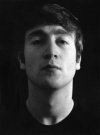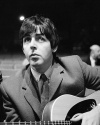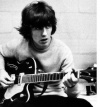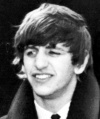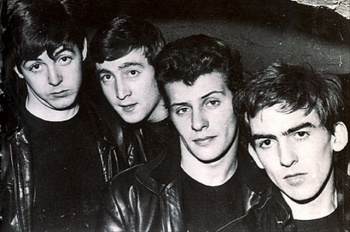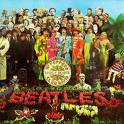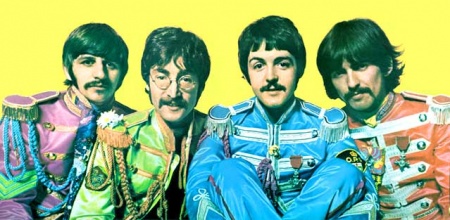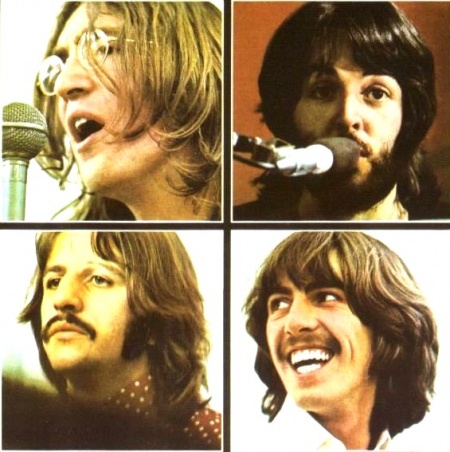The Beatles
Contents |
Introduction
The most famous and influential band there has ever been. The Fab Four changed the face not just of popular music and how it is recorded but also were a great influence in the change of popular culture in the 60’s.
The Beatles were a band formed in the late 1950's that started out playing rock and roll classics but evolved into the most popular pop/rock group of all time. Their recordings have become classics and they have influenced generations of musicians that have followed.
The story of the Beatles is long and complicated but very interesting. Below I hope to give a flavour of what they were about allowing the reader to find out more. Much has beed said and written about them and there is no shortage of material should anyone be interested in finding out more.
Band Members
John Lennon
Guitar and Vocals
Born 9 October 1940 in Liverpool
In March of 1957 John formed his first band The Quarrymen, named after his secondary school in Liverpool (Quarry Bank High School). Through this he met both Paul McCartney and George Harrison.
In 1958 his mother was killed when hit by a car outside his home, this had a big effect on John and perhaps helped cement his friendship with McCartney whose mother had died of cancer two years earlier.
During The Beatles years he did of course form half of the Lennon/McCartney songwriting partnership. John was regarded as the founder and leader of the band. What I admire about his songwriting is its honesty, people would often try to read things into his lyrics but in reality his songs were largely about his life. Of course he had a love of words and some of his songs were based around wordplay, "I am the walrus" springs to mind.
John was often a controversial figure, most famously for saying in an interview in 1966 with Maureen Cleave of the London Evening Standard that The Beatles were more popular than Jesus. This was rather misunderstood particularly in USA and upset the bible belt and the ultra christian Ku Klux Klan which organised burnings of Beatle records. The led to threats against the Beatles and was one of the cotributing events which influenced their decision to end touring.
John left the Beatles in 1969 although this was not anounced for some months. He had a major falling out with McCartney at this time which was never really resolved. Post Beatles John worked with his wife Yoko Ono on several music and art projects and campagned for world peace. He produced several solo albums and produced some of his finest songs such as Imagine.
He last performed like in 1976 and then dropped out of music concentrating on becoming a "househusband" and spending time with his young son Sean.
Unfortunately John was murdered on 8 December 1980 outside the Dakota building in New York by Mark Chapman. This happened at a time when John was returning to music having recently released the Double Fantasy album.
Paul McCartney
Born 18 June 1942 in Liverpool
Paul was encouraged to play music from an early age by his father Jim McCartney who was a piano and trumpet player in a jazz band. He started out on trumpet but swapped his trumpet for an acoustic guitar which being left handed he initially found difficult to play.
He met George Harrison in 1954 as both attended The Liverpool Institute (this has now become the Liverpool Institute Of Performing Arts which McCartney helped to set up in 1996).
Whilst in Hamburg with the Beatles Paul reluctantly became the bands bass player and made famous the Hoffner violin bass which he still plays.
Post Beatles he continued to be successful both as a solo artist and as founding member of Wings with guitarist Denny Laine. Following John Lennons death he bacame wary of touring and Wings were disbanded. Since than he has continued to work in music and has collaborated with many other famous artists including Stevie Wonder, Michael Jackson, Elvis Costello. He has also maintained a close working relationship with Sir George Martin and produced classical works.
George Harrison
Born 24 February 1943 in Liverpool
Guitar and vocals.
The youngest member of the Beatles he took up guitar at an early age. He met Paul McCartney whilst attending Liverpool Institute and through Paul was introduced to John Lennon. John initially thought George to be too young to join his band, The Quarryman but soon relented.
During the Beatles years most of the songs were written by Lennon/McCartney but generally one or two per album were provided by George. George explored different musical genres such as folk and also Indian music and through this helped shape and develop The Beatles Sound. His interest in Indian music led him to learn to play Sitar as was heard on the Sergent Pepper album. After The Beatles, George released a number of successful solo albums and collaborated with many artists during this time. Most notably in 1988 he formed a new band called The Travelling Wilburys with fellow musicians, Bob Dylan, Tom Petty, Jeff Lynne and Roy Orbison. Unfortunately George died of cancer on 29 November 2001
Ringo Starr
Born 7 July 1940 in Liverpool
Ringo was born Richard Starkey but aquired the nickname Ringo because of the rings that he wore.
Prior to joining the Beatles he had played in several Liverpool bands most notably with Rory Storm and The Hurricanes with whom he played in Hamburg alongside the Beatles whose drummer at the time was Pete Best.
He joined the Beatles at the start of their recording career and was an integral part of the band. Hi is regarded as a very influential drummer though not noted for great technical ability.
Post Beatles he has had a very successful career in music and in films and of course is instantly recognisable as the voice of Thomas The Tank Engine!
The “Fifth” Beatle!
There never was a fifth Beatle, however many people played a significant part in the Beatles story.
Pete Best
Born 24 November 1941 in Madras, India.
Pete was Beatles drummer from August 1960 during next two years. He was the Beatles drummer during their time in Hamburg. He was forced from the band and replaced by Ringo on the eve of them beginning their recording career. Many consider him to be the better drummer but it was felt that his image did not fit the band. For example he had refused to cut his hair in the mop top style adopted by the others whilst in Germany.
Mona Best
Mona Best, was the mother of Pete Best, their early drummer and she ran the Casbah Club, a cellar club Liverpool. It was here that the Beatles played some of their earliest gigs.
Allan Williams
Often overlooked but I feel Allan was important in the development of the Beatles. He was owner of the Jacaranda club in Liverpool where the young Beatles would hang out and play the occasional gig. Allan began acting as their booking agent/manager and is responsible for securing them their work in Hamburg, even accompanying them on their first trip. He fell out with The Beatles on their return from Hamburg as they apparently refused to pay his 10% commission.
He wrote a very interesting book “The Man Who Gave The Beatles Away” about his part in their early years which was endorsed by John Lennon. He organised some of the first “Beatles Conventions” in Liverpool and still attends such functions today as a speaker.
Stu Sutcliffe
Born 23 June 1940 in Edinburgh,
Died 10 April 1962 in Hamburg, Germany from a brain hemmorrhage which was probably caused by a terrible beating he received outside a club in Hamburg.
Stu was a talented artist and a great friend of John Lennon. He was never a good musician but was able to buy a bass guitar with prize money which he won in an art competition. He therefore became their bass guitarist from late 1959 until the Beatles second Hamburg trip in 1961. He was shy and would often stand on stage with his back to the audience to hide his poor playing.
Whilst in Hamburg the Beatles met Astrid Kirshner who became Stu’s girlfriend. She changed his clothes and gave him a new, distinctive hair style, which all the Beatles apart from Pete Best later adopted. The moptop was born!
Brian Epstein
Born 19 September 1934 in Liverpool.
Died 27 August 1967 of an accidental drug overdose in London.
Brian was manager of a large family music store called NEMs in Liverpool. Several stories have been put forward as to how the Beatles came to his attention. One of the most popular is that his curiosity was aroused after a customer asked to buy a copy of the single “My Bonnie” which The Beatles had recorded in Hamburg as backing group for singer Tony Sherridan. More likely he was already aware of them as they were by then regularly playing at the Cavern Club and receiving a lot of local publicity via a local music magazine called MerseyBeat. NEMs would have stocked MerseyBeat. Epstein arranged to see The Beatles play at a lunchtime session at the Cavern Club on 9 November 1961. After watching them several more times he took over as their manager on 24 January 1962. He quickly arranged for them to make a demo recording which he touted around various recod companies in London. He was unsuccessful until EMI gave the Beatles their big break.
Brian Epstein also managed other acts, including Gerry and the Pacemakers, Billy J. Kramer, Cilla Black, the Fourmost, the Big Three, the Remo Four and Tommy Quickly.
George Martin
Born 3 January 1926 in London.
George worked as a record producer for Parlophone (part of EMI) and was the producer of all of the Beatles records except for Let It Be. The Beatles worked with George at Studio 2 in Abbey Road Studios. He proved to be very adept at capturing the energy of their performances and developed many new recording techniques in order to turn their ideas and raw songs into commercial recordings.
Mal Evans Mal was The Beatles' roadie from the summer of 1963 until the time of The Beatles break up. He was a constant companion of the band both on the road and in the studio. He set up and tested their equipment, acted as chaufer, bodyguard and gofer. Many Beatles autographs now part of the memorabilia market may in fact have been signed by Evans as the Beatles didn’t have time or the inclination to sign all such requests. He also contributed to several of their songs, with backing vocals, sound effects and played hamond organ. Mal died 5 January 1976 after being shot by police in Los Angeles in a misunderstanding about a gun.
History
Formation and Early Years - Pre Fame
The Beatles began life in early 1957 as The Quarrymen, set up by John Lennon with a group of his school friends from Quarry Bank School in Liverpool. They played a form of music called skiffle. Paul McCartney joined shortly afterwards after meeting the band at a church fete. Paul introduced his school friend, George Harrison to the band and over the next year or so this became their steady lineup. Lennon, McCartney and Harrison (still without a permanent drummer) went through various name changes and played gigs whenever they could and whenever they could find someone to sit in on drums. Eventually the settled on the name The Beatles after a spell as the Silver Beatles. (this is thought to have been influenced by Buddy Holly and The Crickets.)At this time they played many covers of rock and roll songs and were influenced by Buddy Holly, Chuck Berry, Little Richard, Carl Perkins and of course Elvis. Stewart Sutcliffe a friend of Lohn Lennon joined the band on bass though he could hardly play.Even at this early stage Lennon and McCartney began writing their own songs.
They hung around a club in Slater St Liverpool called The Jacaranda owned by Allan Williams who began to get them bookings. Williams secured a residency for them in Hamburg which meant that they needed a permanent drummer and Pete Best was auditioned and then joined the band.
In Hamburg the band played in various clubs (usually strip clubs!) including The Indra, the Kaiserkeller and The Top 10 Club. These were owned by an interesting character named Bruno Koschmider who would urge the band to "mak show". It was here that The Beatles really turned into a tight rock and roll band playing all night gigs. Whilst in Hamburg they met Klaus Boorman and Astrid Kirchner. Astrid became the girlfriend of Stu Sutcliff and also gave the Beatles their famous hairstyles. The Beatles played over 1200 times in Hamburg over a two year period. At the same time they were becoming increasingly popular in Liverpool and began a residency at The Cavern on Matthew St. Brian Epstein took over as their manager and set about getting them a recording deal. Brian was responsible for tidying up their image and making them more professional on stage. After many rejections by record companies they were eventually signed by EMI and began working with George Martin at Abbey Road. Pete Best was sacked and Ringo brought in as drummer.
1962 – 66 Beatlemania
Love Me Do and Please Please me their first singles were instant hits. Epstein proved to be very effective in getting the band exposure and their popularity in the UK quickly spread and Beatlemania was born!
They toured, recorded and worked constantly and in February 1964 made their first visit to the USA. They made their first appearance on USA TV on The Ed Sullivan Show, this gave them great publicity and Beatlemania took hold in the USA also.
During this time they released their first six albums, each one more mature and complex than the last. Rubber Soul (1965) and Revolver (1966) contained some of their finest work in which they began to experiment much more with sounds and recording techniques. Incidentally the cover of Revolver was designed by Klaus Voorman who they had met in Hamburg, and was nos bassist with the Manfred Mann Group. Klaus would also later play with John Lennon in The Plastic Ono Band post Beatles.
By now The Beatles were tired of constant touring, not aided by the fact that they could not be heard on stage. Their Vox AC30 amps were no match for thousands of screeming bands. Vox began developing more powerful 100W amps for them but after a final show in 1966 at Candlestick Park in San Fransisco they gave up on playing live. The 100W amps were utilised by The Who!
Later Years and The Breakup Of The Band
The Beatles became a studio band and they created physcodelic rock which was no doubt influenced by their use of LSD.
Their creativity culminated in what is accepted as one of the most influential albums of all time Sgt. Pepper's Lonely Hearts Club Band released in 1987. The album was groundbreaking and important in many ways. New recording techniques were used including multitracking though recorded on a simple four track tape recorder reduction mixing was used extensively so that layers of sound were built up. The Beatles also made use of new guitar effects such as wah-wah, phasing and flanging. Tape effects were also used in which tape sections were speeded up, slowed down and even played backwards.Even the album cover was innovative being the first ever gatefold cover and featuring a collage of models of famous people. The cover was designed by designed by artist Peter Blake and was the most expensive cover produced up to that date. It was also the first time that an album cover in the UK included the song lyrics.
After the death of Brian Epstein, The Beatles formed their own company Apple Corps which included Apple Records. Part of the ethos of Apple was to support new talent and they had some success with artists including Mary Hopkin, James Taylor, Badfinger, and Billy Preston. Billy Preston accompanied the Beatles on piano, most famously on the rooftop live session on top of the Apple building. James Taylor an excellent guitarist went on to become one of the most respected singer songwriters of his time.
The first Beatles album released on Apple was The White album wich was a bit of a mish mash of ideas, some great songs and some not so great. It really was the beginning of the breakup of the band. The group functioned much less as a unit but more as the backing musiscians for each others songs.
The final two albums Abbey Road, and Let It Be again contained some great moments and were very successful but could not prevent the breakup of the band.
After The Beatles
All four Beatles continued to record and have successful solo careers. There were many calls and offers for them to reform or play together again but it never happened. Perhaps its better that way?
Two interesting projects have taken place in recent years involving The Beatles material.
Firstly,LOVE which is a theatrical production by Cirque du Soleil based around the Beatles music. The music for the show was taked from original Beatles tapes and remastered in 5.1 surround sound by George Martins son.
Secondly in September of 2009 all of their albums have been reissued having been subject to extensive digital remastering. These have had good reviews though I have not listened to them myself as yet.
Equipment
John Lennon
During his career with the Beatles and subsequently he used a huge range of guitars. Perhaps his most famous instruments are:- A Gibson J-160E which was one of the first acoustic-electric guitars ever produced
- He had several Rickenbacker 325’s including a 1958 original model with Bigsby tremolo which was nicknamed Hamburg.
- A Gretsch 6120 which was used on the Revolver sessions.
Paul Macartney
Paul of course is most remembered as popularising the distinctive Hofner Violin bass. He bought the bass in Hamburg and it was used on all of the Beatles early recordings. In the later years of the Beatles he used Rickenbacker 4001S bass.
As far as 6 strings go McCartney has played them all!
George Harrison
George's first electric guitar was a Futurama/Grazioso, which was made in Checozlovakia. Once he began recording at Abbey Road with The Beatles he had access to a wide variety of guitars, however, on early recordings he used mainly Gretsch guitars played through a Vox AC30 amp.
The jangly sound that featured heavily on A Hard Days Night was achieved with a 12 String Rickenbacker, the sound influenced many folk-rock groups of the time.
He acquired a Fender Strat in 1965 and this became his main instrument and was used throughout his solo career.
Ringo Star
Compared to many drummers today Ringo’s kits were often very basic comprising of only four drums (bass, snare, tom and floor tom). He would also use hi-hat and 2 cymbals (one medium ride and one crash). He is most often associated with Ludwig drums and Zildgan cymbals.
For anyone who wishes to know more a book is available written by Andy Babiuk which goes into some detail about the equipment used by the Beatles. It is available at at the usual places including Amazon. Beatles Gear: All the Fab Four's Instruments, from Stage to Studio by Andy Babiuk
Discography
The Beatles basically made 12 studio albums. There have been many compilations and re-releases since the breakup of the band. Most recently the entire catalogue has been digitally re mixed and released in 2009.
1. Please Please Me (22 March 1963)
2. With the Beatles (22 November 1963)
3. A Hard Day's Night (10 July 1964)
4. Beatles for Sale (4 December 1964)
5. Help! (6 August 1965)
6. Rubber Soul (3 December 1965)
7. Revolver (5 August 1966)
8. A Collection of the Beatles Oldies (But Goldies) (10 December 1966)
9. Sgt.Pepper's Lonely Hearts Club Band (1 June 1967)
10. The Beatles (22 November 1968)
11. Yellow Submarine (17 January 1969)
12. Abbey Road (26 September 1969)
13. Let It Be (8 May 1970)
14. The Beatles 1962-1966 (19 April 1973)
15. The Beatles 1967-1970 (19 April 1973)
17. Magical Mystery Tour (18 November 1976)
18. The Beatles Live at the Star-Club in Hamburg, Germany, 1962 (1 May 1977)
19. The Beatles at the Hollywood Bowl (6 May 1977)
20. Love Songs (19 November 1977)
21. The Beatles Collection (13 LP Boxed Set) (2 December 1978)
22. Hey Jude (11 May 1979)
23. Rarities (12 October 1979)
24. The Beatles Ballads (20 October 1980)
25. Reel Music (12 March 1982)
26. The Complete Silver Beatles (10 September 1982)
27. 20 Greatest Hits (18 October 1982)
28. The Beatles Past Masters - Volume I (7 March 1988)
29. The Beatles Past Masters - Volume II (7 March 1988)
30. Live at the BBC (30 November 1994)
31. Anthology I (21 November 1995)
32. Anthology II (18 March 1996)
33. Anthology III (29 October 1996)
34. Yellow Submarine (13 September 1999)
35. Beatles 1 (14 November 2000)
36. Let It Be... Naked (17 March 2003)
37. The Capitol Albums Vol. 1 (15 Nov 2004)
38. Love (20 November 2006)
The Beatles Films
A Hard Day's Night (1964)
Filmed at the height of Beatlemania and though not an out and out documentary the plot does loosely follow what life must have been like for the Beatles at that time. Directed by Dick Lester and starring Wilfred Brambell.
Interestingly Phil Collins had a small role in the film as did Pati Boyd who later went on to be George Harrisons first wife and later married Eric Clapton.
Help! (1965)
Again directed by Dick Lester this film saw the Beatles looking rather more weary and tired, due in part to their hectic schedule but also the large quantities of dope that they were using at the time. The film is a sort of spoof and was filmed in a style that perhaps influenced later films such as the Monkees series in USA and also the early Batman series. The Beatles have stated that they did not enjoy the film and it was in fact the last “scripted” film that they made.
Magical Mystery Tour (1967)
A sort of home movie directed by the Beatles produced this one hour TV film. There was no real script and the end result was not received well!
Yellow Submarine (1968)
An animated film made by producer George Dunning and featuring The Beatles as cartoon characters but voiced by actors. The Beatles themselves only featured in the closing scene. The film was well received.
Let It Be (1970)
This really turned out to be the diary of the breakup of the band. The highlight of the film was undoubtedly the rooftop live session.
The Beatles Anthology (1996)
This was a tv documentary series that told the story of the Beatles career.




